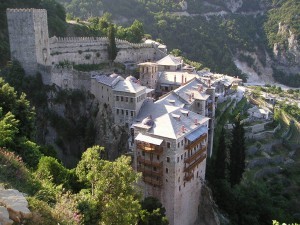‘Conde Nast Traveller’ site goes on a journey to the middle ages. A journey to a place unique on earth, where time has stood still. A journey to the Holy place of Orthodox Christianity, Mouth Athos, in Greece.
From Conde Nast Treveler:
On a small, rocky peninsula jutting out into the Aegean Sea is Mount Athos, home to 20 of the world’s most ancient and remote monasteries. Today, the mountain is an “Autonomous Monastic State” of Greece, but it’s really more like an independent country run by the Eastern Orthodox Church. Visitors must cross border controls to enter from Greece (by boat—there’s no road over the mountain), and the country’s Ministry of Foreign Affairs administers the peninsula. It’s as close as you can get to a Christian Tibet.
Mount Athos might be the quietest inhabited place on Earth.
The first Christians came to Mount Athos in the second century, and their successors there have been holding daily prayers there for more than a thousand years uninterrupted. The monasteries still look like medieval fortresses, unchanged by the centuries. There’s no TV or radio in this ascetic retreat, and visitors will probably never see a phone or car. The result is unearthly quiet, broken only by the tapping of chestnut wood calling the monks to prayer every morning at 3:30 a.m. See, Mount Athos is older than church bells.
A visit to Mount Athos also involves literal time travel. The monasteries there still go by Byzantine time, in which the day begins at sunset, not midnight, so the time zone changes literally every day. Visitors may have to set their watches back by as much as seven hours as they cross the border. And don’t forget to change the date as well. Mount Athos never adopted the new-fangled 16th-century Gregorian calendar; they still use the Julian calendar of the Roman Empire, which lags 13 days behind. It’s almost two weeks ago there!
Their flag is almost as Roman as their calendar.
Mount Athos still flies a yellow flag featuring a double-headed eagle holding a sword and a cross. This was the flag of the medieval Paleologues, the last ruling dynasty of the Byzantine Empire. The Byzantine Empire was the continuation of the Eastern Roman Empire from Constantinople after Rome fell, so, in a way, Mount Athos is the last place on earth where anyone lives under the flag of the Roman Empire.
It’s never Ladies’ Night on Mount Athos.
Mount Athos is hard to get into for men, but downright impossible for women. The monks banned women in the 11th century, even going so far as to ship out all the female animals. (Their one concession to equal rights: letting female songbirds and insects stick around.) No woman has legally set foot across the border in over a thousand years. When the famed British traveler Robert Curzon visited Mount Athos during the Victorian era, he met an orphan who had been raised by the monks there, and had never seen a woman apart from chapel icons of the Virgin Mary. “Do all woman have haloes?” he wanted to know.
Ask me anything
Explore related questions







